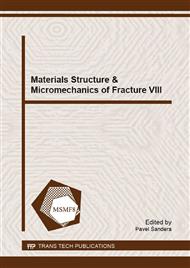p.518
p.522
p.526
p.530
p.534
p.538
p.542
p.546
p.550
Correlation between Dislocation Structures and Mechanical Fatigue Response of 316L Austenitic Steel Loaded with and without Mean Stress at High Temperature in Air and Water Environment
Abstract:
Load-controlled experiments were conducted to study the influence of mean stress on the fatigue behavior of 316L austenitic stainless steel at the temperature of 288°C in air and light water reactor (LWR) conditions. Water environment was characterized by high-purity, neutral water with 150 ppb dissolved hydrogen. The internal dislocation structures of the material were investigated by means of transmission electron microscopy (TEM). The formation of dislocation structures for different loading conditions and different mean stresses was assessed and discussed in relation to the cyclic stress-strain response of the material as well as the effects of non-zero mean stress conditions. All findings were considered to discuss the fatigue softening/hardening behavior and the influence of mean stress on the fatigue life of material in the LWR environment.
Info:
Periodical:
Pages:
534-537
Citation:
Online since:
December 2016
Authors:
Price:
Сopyright:
© 2017 Trans Tech Publications Ltd. All Rights Reserved
Share:
Citation:


